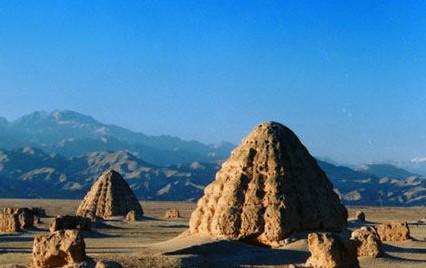Mausoleums of the Western Xia Kingdom
西夏王陵
Yuanhao assumed the imperial title, it was known as the Xia Kingdom.
元昊有皇帝的头衔,被称为夏国王。
In 1227, Western Xia was conquered by Yuan emperor Tai Zu (Genghis Khan).
1227年,西夏被元皇帝元世祖(成吉思汗)征服。
The Western Xia had ten ruling emperors over a 190 year period.
在190年中西夏有十位执政皇帝。
The sites of the imperial mausoleums were chosen nearby at the east foot of the Helan Mountains, 25 kilometers west of Yinchuan City.
帝王陵墓的地点选择在贺兰山山脚东部的附近,在银川以西25公里处。
On the southeast corner at the foot of the Helan Mountains are two large mausoleums,
贺兰山山脚下的东南角是两个大型陵墓,
probably Jialing and Yuling mausoleums of Li Jiqian and li Demin,who were posthumously designated Emperor Tai Zu and Emperor Tai Zong.
可能是太祖李继迁和太宗李德明的嘉陵和裕陵。

The architectural arrangement of the mausoleum area makes these two mausoleums most prominent, followed by others built later.
陵墓的建筑布置使得这两个陵墓最突出,跟着是别人随后建造的。
Like other imperial tombs, Western Xia mausoleums were composed of two architectural units, the mausoleum gardens above ground and underground palaces.
和其他帝王墓一样,西夏陵墓由地上陵墓花园和地宫两个建筑单元组成。
All the mausoleum gardens faced south, and their architectural forms above ground have some unique characteristics,
陵墓花园都朝南,其地面上的建筑都有一些独特的特点,
though they are quite similar to mausoleums of the Tang and Northern Song dynasties in Gongxian County.
尽管他们非常类似于唐,北宋王朝珙县的陵墓。


